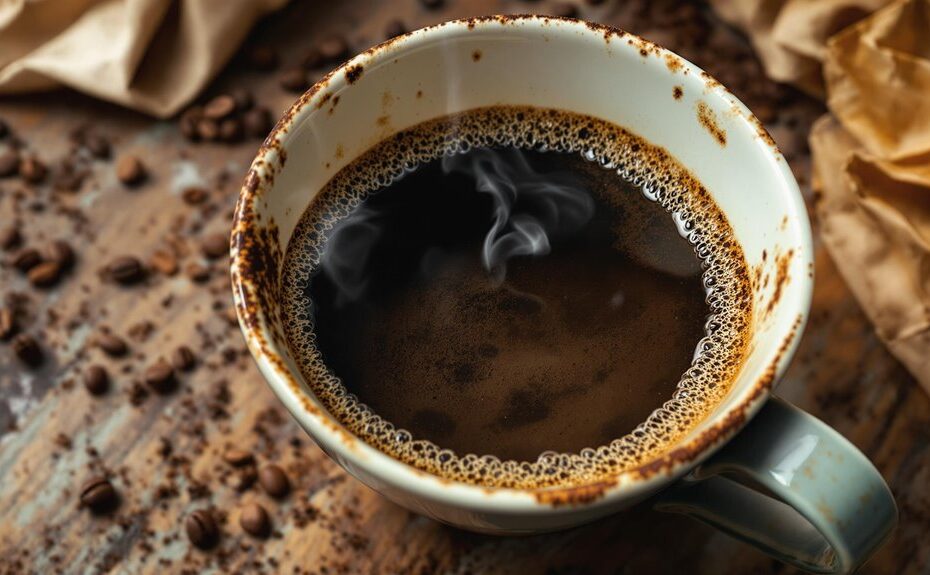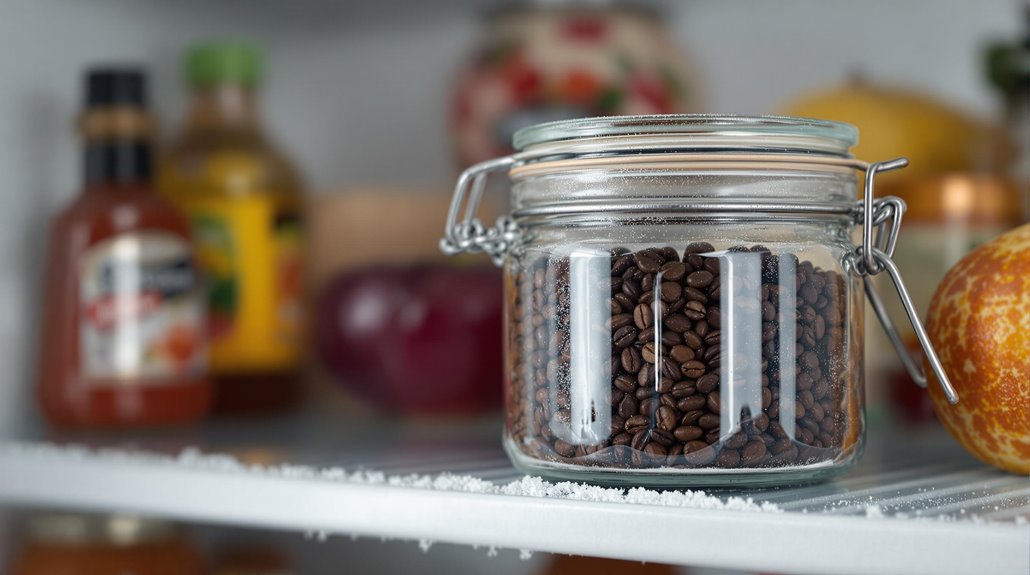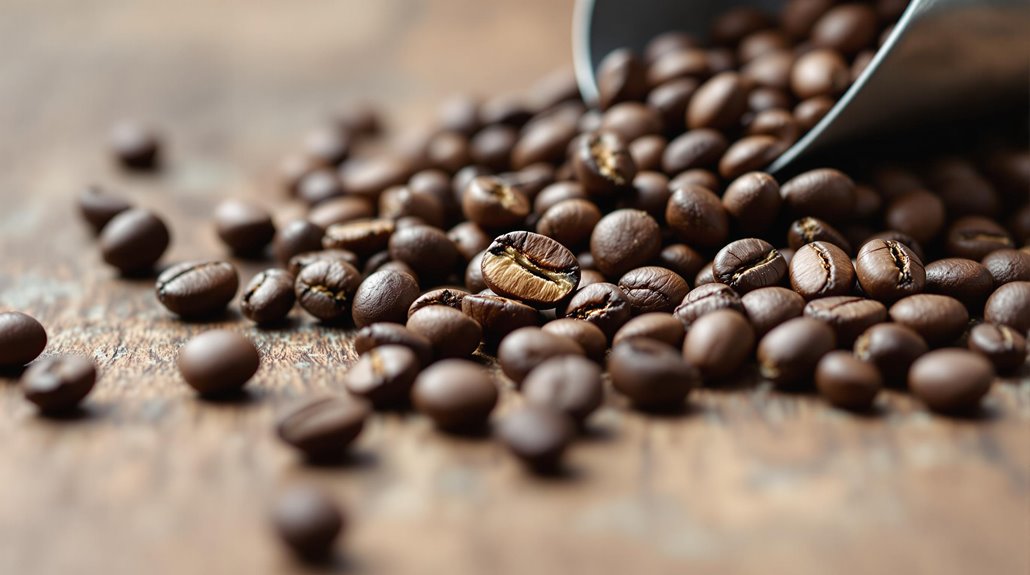







You might not realize that coffee can develop a rancid or musty smell long before it shows visible signs of spoilage. If your brew lacks its usual vibrant aroma or tastes overly bitter or sour, it's likely past its prime. Discoloration, clumping grounds, or an oily sheen on beans can also signal degradation. But how do you distinguish between slightly stale coffee and coffee that's truly gone bad? Understanding the subtle signs and knowing how to test for freshness could save you from a disappointing cup—and maybe even help you salvage what's left.
Key Takeaways
- Check for a musty or rancid smell, which indicates oxidation and spoilage.
- Look for mold growth or clumping in the beans or grounds, signaling moisture exposure.
- Observe discoloration or dullness in the beans, a sign of oxidation and loss of freshness.
- Taste for sour, bitter, or flat flavors, which suggest organic compound breakdown.
- Examine for excessive oiliness on the beans, indicating over-roasting or staleness.
Signs Your Coffee Has Gone Bad
A lack of aroma or a musty, rancid smell is one of the first indicators that your coffee has gone bad. Fresh coffee emits a robust, aromatic scent, but stale coffee beans lose this characteristic due to oxidation and exposure to air. If you detect a rancid smell, it's a clear sign of lipid oxidation, which degrades the oils in the beans. Discoloration, such as a dull gray or tarnished appearance, also signals spoilage, as the natural pigments in coffee degrade over time. Mold growth or clumping in coffee grounds indicates moisture exposure, which creates an environment for microbial contamination. When brewed, spoiled coffee often produces an off-tasting flavor, ranging from excessively bitter to sour, due to the breakdown of organic compounds. Oily residue on the surface of beans may suggest over-roasting or prolonged storage, leading to rancidity. These changes in coffee smells, taste, and appearance are evidence-based markers of degradation. If you notice any of these signs, it's best to discard the coffee to avoid consuming potentially harmful compounds or experiencing an unpleasant, off-tasting flavor.
Factors That Cause Coffee to Spoil
Several key factors contribute to the spoilage of coffee, each impacting its quality and safety. Oxidation is a primary culprit, as exposure to air causes the oils in coffee to degrade, leading to flavor deterioration and a stale taste. High temperatures accelerate this process, speeding up chemical reactions that result in spoilage and a loss of aromatic compounds. Moisture is another critical factor; it creates an environment conducive to bacterial growth and mold, which can render coffee unsafe to consume. UV light also plays a role by breaking down antioxidants and other sensitive compounds, further reducing the coffee's quality over time. Improper storage, such as leaving coffee in open containers or near heat sources, exacerbates these issues, shortening its freshness and shelf life. To preserve your coffee, you must minimize exposure to these factors by storing it in airtight containers, away from light, heat, and humidity. Understanding these elements helps you prevent spoilage and maintain the integrity of your coffee's flavor and safety.
Shelf Life of Different Coffee Types
Whole bean coffee retains its freshness for 6 weeks to 6 months when unopened, extending up to 1 year if nitrogen-flushed to preserve flavor compounds. Ground coffee, however, degrades faster due to increased surface area exposure, lasting up to 3 months in an airtight container before oxidation impacts quality. Proper storage in cool, dark environments minimizes volatile organic compound loss, ensuring peak flavor retention.
Whole Bean Coffee Longevity
Whole bean coffee's shelf life depends on storage conditions and packaging. When stored properly in a cool and dark place, unopened whole coffee beans can retain freshness for 6 weeks to 6 months. Once opened, roasted coffee beans should be transferred to an airtight container to minimize exposure to oxygen, which accelerates the oxidation process and causes them to lose flavor. In an airtight container, opened beans maintain peak freshness for 4–6 weeks. Packaging methods like nitrogen flushing can extend the shelf life of unopened beans to up to 1 year by reducing oxygen exposure. However, freshness declines markedly after the roast date, with ideal flavor lasting only 2–3 weeks post-roast. Freezing whole beans in an airtight container can prolong their shelf life to 3–4 months, though some flavor degradation may occur. Always check the best by date, but prioritize the roast date for evaluating freshness. Proper storage is critical to preserving the aromatic compounds and oils in whole coffee beans, ensuring you enjoy their full flavor profile.
Ground Coffee Freshness Duration
Ground coffee's freshness is greatly influenced by its exposure to oxygen, moisture, and light, with degradation beginning almost immediately after grinding. The increased surface area exposure of ground coffee accelerates the loss of aromatic compounds, leading to a rapid decline in peak flavor. Once ground, coffee retains its ideal taste for only 1-2 weeks if stored in an airtight container in a cool, dark place. Unopened ground coffee can maintain quality until its best-by date, typically 6-12 months from packaging, provided it's stored properly. However, once opened, oxygen exposure causes ground coffee to lose freshness faster than whole beans, as the fine particles are more susceptible to oxidation. Within 20-30 minutes of grinding, the aromatic compounds begin to dissipate, notably reducing flavor intensity. To maximize shelf life, minimize oxygen exposure by sealing ground coffee in an airtight container immediately after use and storing it away from heat and light. Avoid leaving ground coffee in open containers, as this accelerates the loss of freshness. Proper storage practices are critical to preserving the sensory qualities of ground coffee.
Proper Storage to Preserve Freshness
Proper storage is critical to maintaining coffee's freshness and flavor integrity. To preserve the quality of your coffee, store it in an airtight container to minimize exposure to oxygen, which accelerates oxidation and degrades flavor compounds. Whole beans retain freshness longer than pre-ground coffee, so opt for whole beans and grind them just before brewing. Use a sealed container made of opaque or UV-resistant material to block light, which breaks down antioxidants and reduces freshness. Store your coffee in a cool, dark place, ideally between 57-60°F (14-15°C), to protect it from heat and light degradation. Avoid refrigerating or freezing coffee, as moisture and odor absorption can compromise its quality. Purchase coffee in smaller quantities to guarantee you consume it within its peak freshness window. By following these evidence-based practices, you'll maintain the volatile aromatic compounds and flavor profile of your coffee, securing a consistently fresh and enjoyable brew. Proper coffee storage is a simple yet effective way to maximize the sensory experience of your daily cup.
How to Test Coffee for Freshness
To test coffee for freshness, first assess the aroma intensity by grinding a small sample; fresh coffee emits a robust, complex scent, while stale coffee lacks vibrancy. Next, observe the bean appearance, noting that fresh beans exhibit a uniform, rich color without excessive oiliness, which indicates oxidation. Finally, taste the brewed coffee, as fresh coffee delivers a balanced, nuanced flavor profile, whereas stale coffee often tastes flat or overly bitter.
Check Aroma Intensity
Aroma intensity serves as a primary sensory indicator of coffee freshness, offering immediate insight into its quality and degradation state. Fresh coffee typically emits a strong aroma, characterized by sweet and complex notes of fruits, nuts, or chocolate, which are hallmarks of specialty coffee. This rich, fragrant smell is a direct result of volatile organic compounds (VOCs) that are preserved when coffee is freshly roasted and stored properly. Conversely, stale coffee exhibits a marked reduction in aroma intensity, often smelling bland, musty, or like cardboard due to the breakdown of these VOCs over time. Oxidized coffee, in particular, loses its vibrant fragrance, signaling degradation. If the coffee lacks a distinct aroma or smells sour or rancid, it's likely past its prime. To assess freshness, inhale deeply; a robust, complex aroma indicates high-quality, fresh coffee, while a weak or unpleasant smell suggests it's time to discard it. Aroma intensity is a reliable, evidence-based metric for evaluating coffee freshness, making it an essential step in your assessment process.
Observe Bean Appearance
Frequently, the visual characteristics of coffee beans provide critical insights into their freshness and quality. Fresh beans typically exhibit a uniform, rich brown color, free from discoloration or dullness. If you notice a faded or grayish hue, this often indicates oxidation, a chemical process that degrades the beans over time. Oily or shiny surfaces on the beans may suggest over-roasting or staleness, as oils migrate to the surface when beans age. While some oils are normal, excessive shininess often correlates with diminished flavor quality.
Inspect the beans for signs of mold, which appears as fuzzy or discolored patches, or clumping caused by moisture exposure. Mold growth is a definitive indicator of spoilage and poses health risks. Additionally, check for unusual textures, such as excessive dryness or brittleness, which may signal degradation due to improper storage or prolonged exposure to air. By carefully observing these visual cues—rich brown color, absence of discoloration, and lack of mold or moisture—you can assess the freshness of your coffee beans and avoid consuming stale or spoiled products.
Taste for Flavor Quality
How can you determine if your coffee has retained its freshness through taste? Start by brewing a small sample and evaluating its flavor profile. Fresh coffee exhibits a vibrant, complex flavor with distinct notes of fruit, chocolate, or nuts, reflecting the integrity of the oils in the beans. If the coffee tastes flat, dull, or overly bitter, it's likely stale. A sour or musty taste indicates oxidation, a chemical process that degrades the aromatic compounds and oils, leading to a loss of freshness. Stale coffee may also develop a cardboard-like or rancid aftertaste, signaling the breakdown of these oils. Compare the sample to a freshly opened batch; a noticeable decline in flavor intensity or complexity confirms the coffee has lost its freshness. Additionally, if the brew lacks the rich, aromatic qualities you expect, it's a clear sign of degradation. By focusing on these sensory cues, you can accurately assess whether your coffee has gone bad.
Creative Uses for Stale Coffee
Stale coffee doesn't have to go to waste—it can be repurposed in numerous practical and creative ways. Even though stale coffee loses its ideal flavor and aroma, it retains properties that make it useful beyond brewing. For instance, stale coffee grounds serve as an effective natural exfoliant in DIY body scrubs, removing dead skin cells and stimulating circulation. Coffee lovers can also repurpose stale beans or grounds as a nitrogen-rich addition to compost, enhancing soil fertility and promoting plant growth. Additionally, stale coffee grounds act as a natural deodorizer, neutralizing odors in refrigerators, shoes, or garbage disposals. If you have coffee that tastes flat, consider incorporating it into baking recipes like brownies or cakes, where its unique flavor can add depth and richness. Alternatively, brew stale coffee into a cold brew concentrate, which masks its diminished taste and creates revitalizing iced coffee drinks. These methods allow you to maximize the utility of stale coffee, ensuring it doesn't end up in the trash. By exploring these applications, you can extend the lifecycle of your coffee, even after it's past its prime.
Tips to Extend Coffee Shelf Life
To preserve the integrity of your coffee's flavor and aroma, proper storage is essential. For a long shelf life, always store coffee beans or grounds in an airtight container to minimize oxidation, which degrades quality. Choose a container in a cool, dark location, away from moisture, heat, and UV rays, as these factors accelerate the breakdown of coffee compounds. Avoid refrigerating or freezing coffee, as temperature fluctuations can introduce condensation and odors, compromising freshness. If your coffee comes in a sealed package, keep it unopened until use to maintain its peak quality. Once opened, transfer the beans or grounds to an opaque, UV-resistant container to block light exposure, which can degrade antioxidants and alter flavor. Purchase coffee in smaller quantities to guarantee you consume it within several months of the expiration date, ideally within 1-3 weeks post-roasting for the best freshness. By following these evidence-based practices, you'll extend the shelf life of your coffee while preserving its complex flavor profile and aromatic qualities.
Disclosure: As an Amazon Associate, I earn from qualifying purchases.





